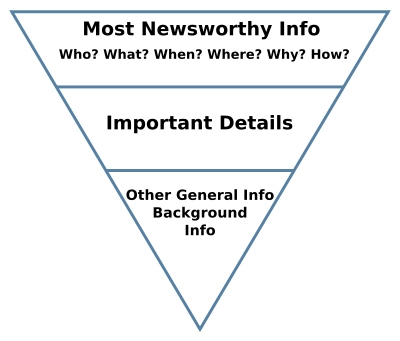This week’s reading for my writing for computer class was focused on content creation and writing key messages. Besides being an important topic, since, without content, your site doesn’t have much to offer, it’s also one that got me thinking about content structure and plain language. Let’s look deeper at some ideas from my reading this week.
This week’s book chapter started by giving us seven guidelines to help focus our conversation when creating or rewriting content.
- Give people only what they need.
- Cut! Cut! Cut! And cut again!
- Think “bite, snack, meal.”
- Start with your key message.
- Layer information.
- Break down walls of words.
- Plan to share and engage through social media.
A couple of these ideas stood out to me. First, “bite, snack, meal” is a great way to remember how to break up your content so that your reader can find the information they’re looking for and then have options regarding how much of that information they want to read. “Bite” is your headline or the section heading. It lets them know what the information that follows is focused on. “Snack” expands on the bite by giving the key ideas or a summary of what the rest of the content is about. “Meal” is the rest of the information that offers all the details. If a reader is looking for something, they can skim the “bites” to find it, then read the “snack” to make sure it’s what they’re looking for, and if it is, they can then read the “meal.” This means that your “bite” or headline needs to be accurate and informative.
This reminded me of task-oriented headlines that I learned about in another class. With task-oriented headlines, you’re writing headlines that tell the user exactly what the section contains. For example;
“Cropping a Photo” versus “How to Crop a Photo in Microsoft Paint”
The second option tells the user that this section will tell them how to crop a photo in a specific software, whereas the first could just be talking about why you might crop a photo. I found Task-Oriented Writing for Techies very helpful when studying task-oriented headlines.
Another idea that resonated with me was using the inverted pyramid to ensure you start with your key message. I recall this concept from my time writing for my high school newspaper. It’s a fundamental concept in journalism where you begin your article with the key information (generally the who, what, when, where, why, and how), then follow it with the additional facts that directly support that information, and finally end with any other background or history. It ensures the reader gets the most critical information first; if you still have their attention, they can get more information.

Given that most of us have a much shorter attention span than we used to, this makes even more sense to me. Giving the user the most critical information first helps to ensure that they read it rather than burying it in the middle of the content when they may have lost interest and moved on to the next thing. A website article mentioned in the textbook, Writing from the Top Down: Pros and Cons of the Inverted Pyramid, offers even more information on how to write using the inverted pyramid. It’s written from a journalist’s point of view but is still very relevant for content creation.
We also read an article, How to create compelling key messages, which gave some advice on how to focus your key messages consistently, is clearly understood by the audience, and ideally, engages your reader so that they want to know more. A few things I found very interesting to remember were that the key message isn’t always the headline itself but the main idea or message from which headlines can be created. After reading this article, I was able to look at the website of the wellness clinic I work for and see that one of our key messages is:
The Hub is dedicated to offering comprehensive natural alternative healthcare for pain, autoimmune disorders, neurodegenerative diseases, and emotional disorders.
I could then see how the key message is backed up by information on services we offer and how they can help with or treat various ailments.
This article also got me thinking about how crucial plain language is in ensuring your message is as straightforward as possible. A book I’ve been studying for another class is the Oxford Guide To Plain English which has thirty guidelines on how-to ways to write using plain language.
A copy is available on the Internet Archive, which you can borrow for an hour at a time if you’d like to take a look.
Overall I found the ideas and guidelines in this week’s readings very useful in considering what information to include in creating content and how best to organize it so that the user can find what they’re looking for and read it. Here are some links to the readings and a few additional resources I came across when doing further research for this post that you might find interesting.
- Readings
- Textbook: Letting Go of the Words: Writing Web Content that Works, 2nd edition, by Janice (Ginny) Redish,
- Chapter 7 Focusing on Conversations and Key Messages and Interlude 2: Finding the Marketing Moments
- Article: How to create compelling key messages by Kim Harrison
- Textbook: Letting Go of the Words: Writing Web Content that Works, 2nd edition, by Janice (Ginny) Redish,
- Links mentioned
- Additional References
- What is Content, Anyway? by Max Swisher
- Discuses what is considered content
- Inverted Pyramids in Cyberspace By Jakob Nielsen
- Discusses using the inverted pyramid style for writing online
- Information Architecture: Constructing with content by Pamela Kostur
- Talks about how to write content in blocks so that it can be reused (modular content)
- What is Content, Anyway? by Max Swisher
